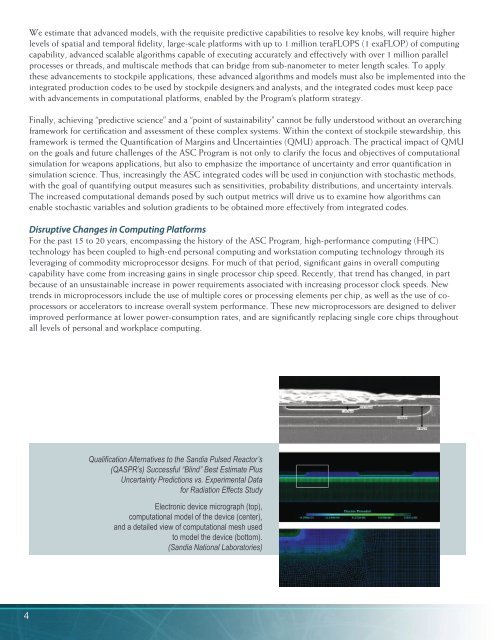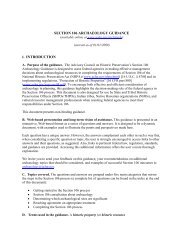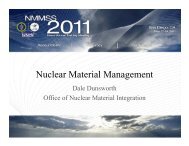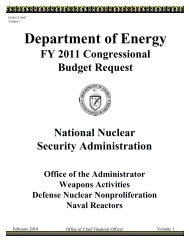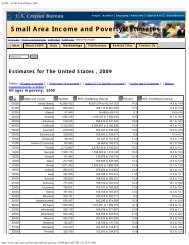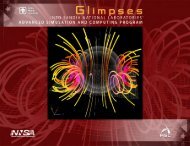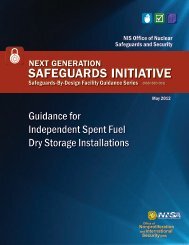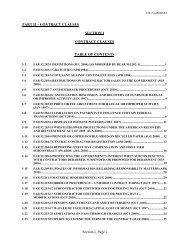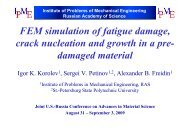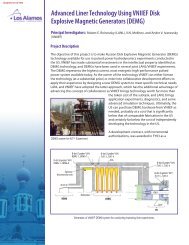ASC Code Strategy - National Nuclear Security Administration
ASC Code Strategy - National Nuclear Security Administration
ASC Code Strategy - National Nuclear Security Administration
Create successful ePaper yourself
Turn your PDF publications into a flip-book with our unique Google optimized e-Paper software.
We estimate that advanced models, with the requisite predictive capabilities to resolve key knobs, will require higher<br />
levels of spatial and temporal fidelity, large-scale platforms with up to 1 million teraFLOPS (1 exaFLOP) of computing<br />
capability, advanced scalable algorithms capable of executing accurately and effectively with over 1 million parallel<br />
processes or threads, and multiscale methods that can bridge from sub-nanometer to meter length scales. To apply<br />
these advancements to stockpile applications, these advanced algorithms and models must also be implemented into the<br />
integrated production codes to be used by stockpile designers and analysts, and the integrated codes must keep pace<br />
with advancements in computational platforms, enabled by the Program’s platform strategy.<br />
Finally, achieving “predictive science” and a “point of sustainability” cannot be fully understood without an overarching<br />
framework for certification and assessment of these complex systems. Within the context of stockpile stewardship, this<br />
framework is termed the Quantification of Margins and Uncertainties (QMU) approach. The practical impact of QMU<br />
on the goals and future challenges of the <strong>ASC</strong> Program is not only to clarify the focus and objectives of computational<br />
simulation for weapons applications, but also to emphasize the importance of uncertainty and error quantification in<br />
simulation science. Thus, increasingly the <strong>ASC</strong> integrated codes will be used in conjunction with stochastic methods,<br />
with the goal of quantifying output measures such as sensitivities, probability distributions, and uncertainty intervals.<br />
The increased computational demands posed by such output metrics will drive us to examine how algorithms can<br />
enable stochastic variables and solution gradients to be obtained more effectively from integrated codes.<br />
Disruptive Changes in Computing Platforms<br />
For the past 15 to 20 years, encompassing the history of the <strong>ASC</strong> Program, high-performance computing (HPC)<br />
technology has been coupled to high-end personal computing and workstation computing technology through its<br />
leveraging of commodity microprocessor designs. For much of that period, significant gains in overall computing<br />
capability have come from increasing gains in single processor chip speed. Recently, that trend has changed, in part<br />
because of an unsustainable increase in power requirements associated with increasing processor clock speeds. New<br />
trends in microprocessors include the use of multiple cores or processing elements per chip, as well as the use of coprocessors<br />
or accelerators to increase overall system performance. These new microprocessors are designed to deliver<br />
improved performance at lower power-consumption rates, and are significantly replacing single core chips throughout<br />
all levels of personal and workplace computing.<br />
Qualification Alternatives to the Sandia Pulsed Reactor’s<br />
(QASPR’s) Successful “Blind” Best Estimate Plus<br />
Uncertainty Predictions vs. Experimental Data<br />
for Radiation Effects Study<br />
Electronic device micrograph (top),<br />
computational model of the device (center),<br />
and a detailed view of computational mesh used<br />
to model the device (bottom).<br />
(Sandia <strong>National</strong> Laboratories)<br />
4


